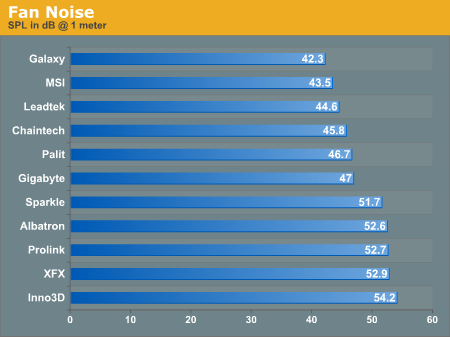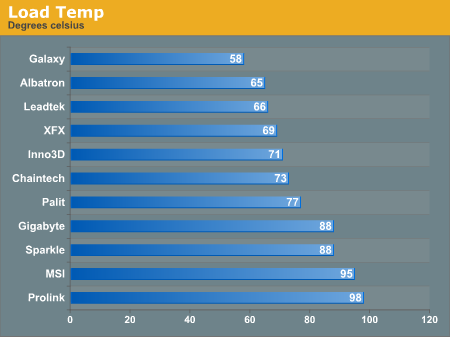Noise and Heat
Here are the meat and potatoes of our comparison between the 11 Geforce 6600GT cards today. How quiet and efficient are the cooling solutions attached to the cards? We are about to find out.Our noise test was done using an SPL meter in a very quiet room. Unfortunately, we haven't yet been able baffle the walls with sound deadening material in the lab, and the CPU and PSU fans were still on as well. But in each case, the GPU fan was the loudest contributor to the SPL in the room by a large margin. Thus, the SPL of the GPU is the factor that drove the measured SPL of the system.
Our measurement was taken at 1 meter from the caseless computer. Please keep in mind when looking at this graph that everyone experiences sound and decibel levels a little bit differently. Generally, though, a one dB change in SPL translates to a perceivable change in volume. Somewhere between a 6 dB and 10 dB difference, people perceive the volume of a sound to double. That means the Inno3D fan is over twice as loud as the Galaxy fan. Two newcomers to our labs end up rounding out the top and bottom of our chart.
The very first thing to notice about our chart is that the top three spots are held by our custom round HSF solutions with no shroud. This is clearly the way to go for quiet cooling.
Chaintech, Palit, and Gigabyte are the quietest of the shrouded solutions, and going by our rule of thumb, the Palit and Gigabyte cards may be barely audibly louder than the Chaintech card.
The Albatron, Prolink, and XFX cards have no audible difference, and they are all very loud cards. The fact that the Sparkle card is a little over 1 dB down from the XFX card is a little surprising: they use the same cooling solution with a different sticker attached. Of course, you'll remember from the XFX page that it seems that they attached a copper plate and a pad to the bottom of the HSF. The fact that Sparkle's solution is more stable (while XFX has tighter pressure on the GPU from the springs) could mean the slight difference in sound here.
All of our 6600 GT solutions are fairly quiet. These fans are nothing like the ones on larger models, and the volume levels are nothing to be concerned about. Of course, the Inno3D fan did have a sort of whine to it that we could have done without. It wasn't shrill, but it was clearly a relatively higher pitch than the low drone of the other fans that we had listened to.

NVIDIA clocks its 6600 GT cores at 300 MHz when not in 3D mode, and since large sections of the chip are not in use, not much power is needed, and less heat is dissipated than if a game were running. But there is still work going on inside the silicon, and the fan is still spinning its heart out.
Running the coolest is the XFX card. That extra copper plate and tension must be doing something for it, and glancing down at the Sparkle card, perhaps we can see the full picture of why XFX decided to forgo the rubber nubs on their HSF.
The Leadtek and Galaxy cards come in second, pulling in well in two categories.
We have the feeling that the MSI and Prolink cards had their thermal tape or thermal glue seals broken at some point at the factory or during shipping. We know that the seal on the thermal glue on the Gigabyte card was broken, as this card introduced us to the problems with handling 6600 GT solutions that don't have good 4 corner support under the heatsink. We tried our best to reset it, but we don't think that these three numbers are representative of what the three companies can offer in terms of cooling. We will see similar numbers in the load temp graphs as well.

Our heat test consists of running a benchmark over and over and over again on the GPU until we hit a maximum temperature. There are quite a few factors that go into the way a GPU is going to heat up in response to software, and our goal in this test was to push maximum thermal load. Since we are looking at the same architecture, only the particular variance in GPU and the vendor's implementation of the product are factors in the temperature reading we get from the thermal diode. These readings should be directly comparable.
We evaluated Doom 3, Half-Life 2, 3dmark05, and UT2K4 as thermal test platforms. We selected resolutions that were not CPU bound but had to try very hard not to push memory bandwith beyond saturation. Looping demos in different levels and different resolutions with different settings while observing temperatures gave us a very good indication of the sweet spot for putting pressure on the GPU in these games, and the winner for the hardest hitting game in the thermal arena is: Half-Life 2.
The settings we used for our 6600 GT test were 1280x1024 with no AA and AF. The quality settings were cranked up. We looped our at_coast_12-rev7 demo until a stable maximum temperature was found.
We had trouble in the past observing the thermal diode temperature, but this time around, we setup multiple monitors. Our second monitor was running at 640x480x8@60 in order to minimize the framebuffer impact. We kept the driver open to the temperature panel on the second monitor while the game ran and observed the temperature fluctuations. We still really want an application from NVIDIA that can record these temperatures over time, as the part heats and cools very rapidly. This would also eliminate any impact from running a second display. Performance impact was minimal, so we don't believe temperature impact was large either. Of course, that's no excuse for not trying to do thing in the optimal way. All we want is an MBM5 plugin, is that too much to ask?
It is somewhat surprising that Galaxy is the leader in handling load temps. Of course, the fact that it was the lightest overclock of the bunch probably helped it a little bit, but most other cards were running up at about 68 degrees under load before we overclocked them. The XFX card, slipping down a few slots from the Idle clock numbers with its relatively low core overclock, combined with the fact that our core clock speed leader moves up to be the second coolest card in the bunch, makes this a very exciting graph.
For such a loud fan, we would have liked to see Inno3D cool the chip a little better under load, but their placement in the pack is still very respectable. The Sparkle card again shows that XFX had some reason behind their design change. The added copper bar really helped them even though they lost some stability.

The Gigabyte (despite my best efforts to repair my damage), MSI, and Prolink cards were all way too hot, even at stock speeds. I actually had to add a clamp and a rubber band to the MSI card to keep it from reaching over 110 degrees C at stock clocks. The problem was that the thermal tape on the RAM had come loose from the heatsink. Rather than having the heatsink stuck down to both banks of RAM as well as the two spring pegs, the heatsink was lifting off of the top of the GPU. We didn't notice this until we started testing because the HSF had pulled away less than a millimeter. The MSI design is great, and we wish that we could have had an undamaged board. MSI could keep this from happening if they put a spacer between the board and the HSF on the opposite side from the RAM near the PCIe connectors.










84 Comments
View All Comments
geogecko - Friday, December 10, 2004 - link
#33. I agree completely. That's why I'm curious about the HDTV output. I want to build an HTPC that is somewhat future-proof, and if that is the case, then I need the HDTV Out feature to work. From a review on newegg.com's web site on the XFX card, he couldn't seem to get and HDTV Out to work with the card.NVDVD would also be a plus if it was included, but I doubt it. I sent an e-mail to tech support over at XFX, asking these particular questions. Hopefully, I'll get an answer.
jamawass - Friday, December 10, 2004 - link
Well there's more to a graphics card than gaming. The 6600 series is causing quite a stir in the htpc community because of the video decoding capabilites and hdtv output. It would've been helpful if the reviewer had mentioned the various manufacturers' suppport for HDTV output out of the box, which cards come with the NDVD codec, component adapter etc.bigpow - Friday, December 10, 2004 - link
-> hex value 3 = decimal value 3geogecko - Friday, December 10, 2004 - link
Great article Derek. Been looking for a 6600GT round up article for a while now.Question though. A few of these cards come with an HDTV cable, which, I guess I'm a little confused to what this actually is. I prefer the XFX card, because of the dual DVI outputs (and no need to overclock the card). It doesn't list as coming with an HDTV cable, so I'm wondering, what is the impact on not having this cable? What is the cable? Can't one usually just hook up a DVI cable to an HDTV?
Spacecomber - Friday, December 10, 2004 - link
Nice round-up, and your bringing attention to the potential problems with some of the heatsinks is very much appreciated.Maybe as a follow up we need a round-up of some after-market heatsinks for the 6600GT.
Any reason to assume that these conclusions reached for the PCIe cards do or do not apply to the AGP versions? I know the AGP versions typically have their heatsinks set on a diagonal in order to accomodate the bridge chip.
Space
arswihart - Friday, December 10, 2004 - link
my last comment was in response to #25#27 - Derek is talking about his "IT friendly" list, those cards he felt had the most reliable hsf implementation
arswihart - Friday, December 10, 2004 - link
it does consistently lead in performance, worth noting by all means, but also, as it was mentioned in the review, these cards probably all perform even better on an nforce4, and the rank and file in performance among these cards might be a little different on an nforce4but I would definitely get an arctic cooler for the albatron anyways (if a compatible one is released) to quiet it down, that fan on it is tiny, thin, and loud
Houdani - Friday, December 10, 2004 - link
On the last page [Final Words] you are listing why some cards aren't worthy of an Editor's Choice award. The next to last paragraph states:"XFX doesn't make the list because..."
But, ummm, isn't XFX the Silver choice?
Aquila76 - Friday, December 10, 2004 - link
I know the Albatron didn't have a great mounting mechanism, but it was better than many of the othersAquila76 - Friday, December 10, 2004 - link
Why wasn't the Albatron given any medal? It has the best OC, best or near best performance in all the tests, and great temps even under load with the high OC. So the fan is a little noisier than the rest, is that any reason to dirt on this card?